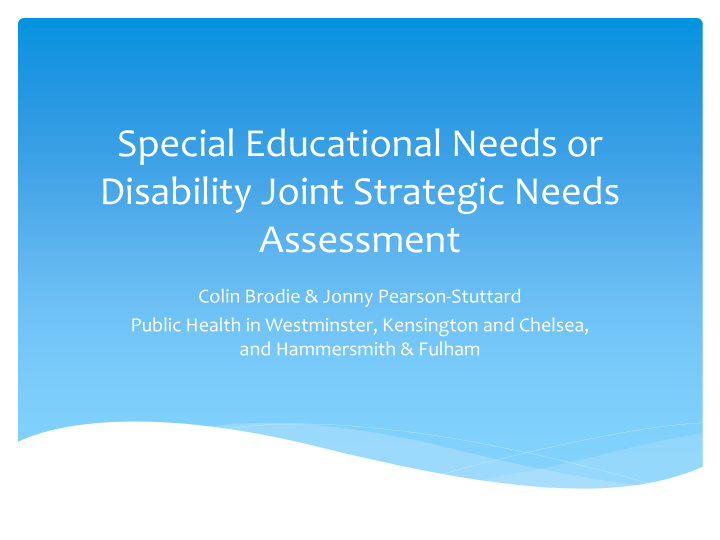



Special Educational Needs or Disability Joint Strategic Needs Assessment Colin Brodie & Jonny Pearson-Stuttard Public Health in Westminster, Kensington and Chelsea, and Hammersmith & Fulham
Why are we here? Joint Strategic Needs Assessment (JSNA) www.jsna.info www.jsna.info/online Legal requirement of local Health & Wellbeing Boards Previous topics include: Young Adults Housing & Care Childhood Obesity
SEND JSNA Children & Families Act 2014 Health bodies inform parent of children with SEND SEND Code of practice: Cooperation of all local partners in education, health and social care JSNA to inform commissioning and local offer
Scope of the SEND JSNA Children and young people aged 0-25 Living in Hammersmith & Fulham, Westminster, or Kensington and Chelsea With Special Educational Needs or ‘SEN’, particularly: Autistic Spectrum Disorders Learning Disabilities Learning Disabilities Speech, Language and Communication Needs
SEND: complex associations Joseph Rowntree Foundation Report
Number of children nationally with SEN Statement by age over time Children and young people with statements or EHC plans in January each year 140,000 120,000 100,000 Under 5 years of age 80,000 Axis Title Aged 5-10 Aged 11-15 60,000 Aged 16-19 Aged 20-25 40,000 20,000 0 2010 2011 2012 2013 2014 2015 2016
Local demographics Hammersmith Westminster Kensington & London England & Fulham Chelsea average average Proportion of White British to BME pupils White 27.1% 14.0% 21.9% 27.8% 70.0% British BME 72.9% 86.0% 78.1% 72.2% 30.0% Estimated numbers receiving SEN support BME pupils 3443 4726 2273 6476 3730
What we know locally School age children receiving SEN support Hammersmith & Kensington & England LA Westminster London average Fulham Chelsea average # % # % # % # % # % Primary 1713 16.1% 1033 14.1% 1689 15.1% 3111 13.8% 4073 13.4% Secondary 1104 12.6% 469 9.8% 2107 18.9% 2050 13.7% 2674 12.7% Special 457 100% 162 88.5% 198 100% 444 97.7% 711 99% Total 3274 16.5% 1590 13.5% 3994 17.7% 5599 14.8% 7458 14.3%
By School stage? Percentage of school-age children with SEN support or SEN service 20.00% 18.00% 16.00% 14.00% 12.00% Primary 10.00% Secondary 8.00% 6.00% 4.00% 2.00% 0.00% H&F Kensington & Chelsea Westminster London average England LA average
What we know so far More school-age children in Hammersmith & Fulham and Westminster receive SEN support than the London or England average Speech, Language & Communication Needs are the most common type of SEN locally Registered prevalence of learning disability is lower in the three boroughs than the London or England average
What we know so far Local professionals have identified that there is… Inequity in services such as speech & language therapy A lack of pre-school provision for children with learning disabilities before they can be placed in a special school A lack of pre-school support for children with autism in Hammersmith and Fulham and Westminster A risk of children falling off a ‘cliff edge’ at transition stages
We need to know… What are the biggest issues/problems affecting health and care for people with special educational needs? What local services (in education, health, councils, or charities) are you aware of for children and young people with SEN? What are your experiences of using these services? What good practice locally do you know of? What is the role of the third sector for children and young people with SEN?
SEND JSNA Questions?
Recommend
More recommend